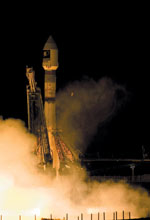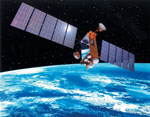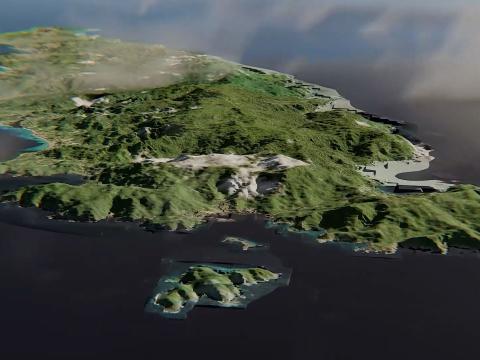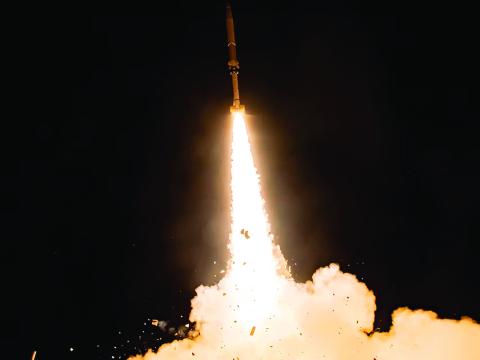 |
| A Soyuz-Fregat launch vehicle blasts off from a pad at Baikonour spaceport in Kazakhstan carrying Giove-B, the second Galileo validation demonstrator satellite. The United States is working with the European Space Agency to ensure Global Positioning System interoperability with the Galileo geopositioning system. |
Greater commercial and military cooperation is taking place across national borders.
As aerospace operations increasingly beckon, the U.S. Air Force is looking across the Atlantic as well as skyward. It has created a new liaison office designed to coordinate and boost space cooperation with Europe. This comes as both civil government and military entities across the continent are deploying new space-based systems that can complement or enhance U.S. capabilities.
The new director, European space liaison, is Col. Richard McKinney, USAF (Ret.), who has 25 years of involvement in space and missile programs. The newly formed post resides under the Office of the Under Secretary of the Air Force. “The Air Force recognized within the last year or so that it really needed a greater presence and knowledge of space in Europe,” explains McKinney. “The purpose of the job is several-fold, but the main one is to facilitate cooperation in space with our European allies.”
Ron Sega, the former under secretary of the Air Force and the Defense Department’s executive agent and milestone decision authority for space, drove this decision, according to McKinney. “In the past, there wasn’t even anyone to discuss these issues with in Europe,” McKinney notes. “You had to go to the United States, and we handled it on a need-be basis. I don’t want to say ad hoc, because it was more formal than that.”
The European space liaison position initially will last for three years. “What I am really hoping to achieve is that this position becomes an asset to use in terms of working with the United States on all matters regarding space, and to help facilitate and to provide better cooperation on matters of space where it makes sense for both parties to do so,” McKinney declares. He concedes that it may not be a universal panacea, however. “Sometimes that makes sense, sometimes not.”
The National Aeronautics and Space Administration (NASA) has had a similar position since 1964, but it mainly deals with civil space and the European Space Agency (ESA). Some overlap is inevitable between NASA’s mission in Europe and that of the Air Force’s European space liaison. “Even in the United States, the Air Force works closely with NASA,” McKinney observes. “They use the same launch sites and rockets, and certainly some of the technologies are the same so there is a natural amount of overlap. I would go on to further say that [the European space liaison’s role] is also to improve and to expand our relationship on space matters to include science and technology, defense development and civil applications for space where there is dual-use capability such as weather satellites and potentially access to space.”
This new liaison also takes into account the many definitions of “European,” McKinney acknowledges. “It’s a new position, and the areas we are initially concentrating on are the European Union and NATO. Then we will move beyond that. Russia, however, is a completely different question because it has a significant space capability already in one country.
“I would say that Europe as whole has a very robust space capability,” McKinney adds. “You have to look at the whole to look at the overall space capability because there are different capabilities in each country.” The liaison position currently is based in Paris, which reflects France’s investment in space. He notes that on an annual basis France spends more money in space than any other European country.
He observes that working with allies requires an understanding of capabilities on both sides. That cannot be done effectively in the final last-minute run up to future operations. It must be done on a long-term, ongoing basis, which is what he is actively pursuing as part of his remit. Col. McKinney compares this to international relationships among air forces.
“In the air, we have exchange pilots and we cooperate on exercises and we certainly deploy together. In order to operate together, you have to have some knowledge of each other’s operational capabilities, techniques and limitations to get the most efficient use of our assets. Maybe someday we will be in the same position to do so in space. That will take a period of discussion to figure out the first steps and determine what would be mutually beneficial. Without having knowledge of those capabilities and ways to facilities those discussions, that will take longer. You could say that this new position is an integral part of that [effort].”
 |
| The U.S. Advanced Extremely High Frequency (AEHF) program already has three allied users signed up: Canada, the Netherlands and the United Kingdom. U.S. planners seek to establish a similar model for cooperation for the Transformational Communications Satellite, or TSAT. |
McKinney also identifies ongoing operations in
Iraq and
Afghanistan as instrumental in developing the broad thrust and details of that future relationship. “The more operational experience we get, the more that is going to shape how we do business in the future. As space becomes more important, the knowledge of how the systems work together and can be complementary becomes more and more important. It will help and it facilitates future discussion, but again it is a step-by-step basis. You take a step, see how you can improve it, and then you take the next step and follow on from there.”
One of McKinney’s recent roles was to represent the United States—and specifically the Global Positioning System (GPS)—at the annual Munich Satellite Navigation Summit. This year’s February event followed a crucial period for Europe’s Galileo satellite navigation program. Although Galileo is now moving ahead and successfully launched its second demonstrator satellite Giove-B from the Baikonur Space Center, Kazakhstan, in April, it had to be rescued with public funding from EU finance ministers in November.
McKinney notes that the United States works with the Galileo program on an ongoing basis. “I was with the Defense Department negotiation team in 2003 when Galileo was finalizing its signal structure,” he relates. “We wanted to make sure that the signal structure they chose was compatible and interoperable with GPS. Discussions over a period of months ensured that the signal gave them the best possible capability but, at the same time, was interoperable with our systems. Since then we have had excellent cooperation on Galileo to ensure that that relationship stays in place. There have been a number of different technical groups where we have had to refine the signal and further approve it from what our initial agreement was. That is all done at the technical level.”
He relates that, at the Munich summit, those involved on the European side said they were quite pleased with the cooperation and how things had progressed. “On all sides it has worked out quite well,” he offers.
However, technology transfer is not being discussed. “We each have our own individual interests and we each want to make sure what we do doesn’t cause harm to each other’s signals,” the colonel elaborates. “We each watch out over what is occurring, but we don’t go into details. We try to stay away from technology transfer. They have their experts, we have our experts, and in the end it all works out just fine.”
The United States has been developing space usage models and assets that allies are utilizing and assisting in funding, most notably in satellite communications. In November 2002, three countries signed a memorandum of understanding with the United States to use the U.S. Advanced Extremely High Frequency (AEHF) satellite system. Late last year, a more significant development occurred with an $816 million contract that was signed to launch a sixth Wideband Global Satellite Communications (WGS) satellite, funded by the Australian Defence Force’s (ADF’s) Joint Project 2008.
European nations have looked at this arrangement with interest, according to McKinney, but only as another approach to providing MILSATCOM capability. “I think each individual country’s needs and requirements would dictate the solution,” he offers. “Wideband, for example, is a nonsecure communication capability. Skynet, Sicral and Syracuse all have greater capabilities for [secure] military communications. [The Australian WGS example] is just another tool in the tool box in terms of how you can get broadband capability.”
Those issues are influencing interest in availability over commercial Satcom alternatives, he points out. “It certainly seems that availability of communications is decreasing because there is a bigger commercial demand for it. So when you put all that together, you will probably look at other ways to provide nonsecure communications when you need that. WGS is one of those ways. Leasing space on Skynet or Xtar is another way to look at it. It depends on short-term and long-term needs, whether it is in the right place and obviously the cost.”
The approach pursued on AEHF is less radical than that adopted on WGS and also may attract more users. This approach may be requested for future space capabilities such as the Transformational Communications Satellite (TSAT) program.
“I’m not aware of any [AEHF interest from other countries], but that doesn’t mean there won’t be in the future,” McKinney states. “We are certainly not precluding it. We certainly expect that question to be asked [about TSAT], but we currently are concentrating on the AEHF program and getting that up and operating. Then countries will have a chance to see how advanced AEHF is in meeting their needs and requirements. There will be time later on to discuss whether that could be extended to TSAT.”
Most of what the European Space Agency does remains firmly in the civil domain, orienting its interests toward NASA. The European Defence Agency (EDA) is a more recent organization with interests in military space. The EU formed the EDA in 2004 to promote cooperation in defense capabilities and research among members. An absence of clear policy direction for how the EDA should respond to the challenges of military space initially meant that there was little relevance to the role of the European space liaison. However, that now appears to be changing.
“The EDA and the EU need to determine the areas they want to explore and develop,” explains McKinney. “Then we will see if there are areas for future cooperation. I think whether or not a European space policy develops will dictate most of that.”
That limited involvement is determined to large extent by the European space liaison. “Most of my work isn’t in the policy end,” he emphasizes. “That is the responsibility of the Office of the Secretary of Defense. Once policy is established, my role is to support how you implement it and what would make sense in terms of cooperation and interoperability. Right now, Europe is in the process of establishing that capability. That is what we are looking at.”
Change on that front is becoming apparent, McKinney adds. “There has been some reporting that the French will make that [an EU] discussion item in the second half of this year, with the idea of creating just that—where do we want to go, what is our policy and where we should invest our funds. I think that will be a key point in determining where we all go together.”
Web Resources
ESA Galileo: www.esa.int/esaNA/galileo.html
AEHF: www.losangeles.af.mil/library/factsheets/factsheet.asp?id=5319
WGS: www.afspc.af.mil/library/factsheets/factsheet.asp?id=5582






Comments